Nursing Assignment: Strategies to Combat Ageing Biases in Healthcare
VerifiedAdded on 2023/04/25
|8
|2123
|275
Essay
AI Summary
This essay reflects on the pervasive issue of ageism within healthcare, particularly its impact on elderly patients. It begins with a personal reflection on caring for elderly patients, emphasizing the importance of holistic and culturally safe care. The discussion highlights observed biases such as dismissing medical complaints as mere consequences of aging and perpetuating ageist remarks. To combat these biases, the essay proposes a community education plan targeting healthcare professionals, focusing on addressing institutionalized ageism, ensuring patient comfort through culturally sensitive care, and advocating for patient rights to eliminate age-related discrimination. The plan includes seminars, workshops, informative posters, and emphasizes the importance of specializing in geriatric care to foster a respectful environment for elderly patients. Desklib offers this and many other resources for students.
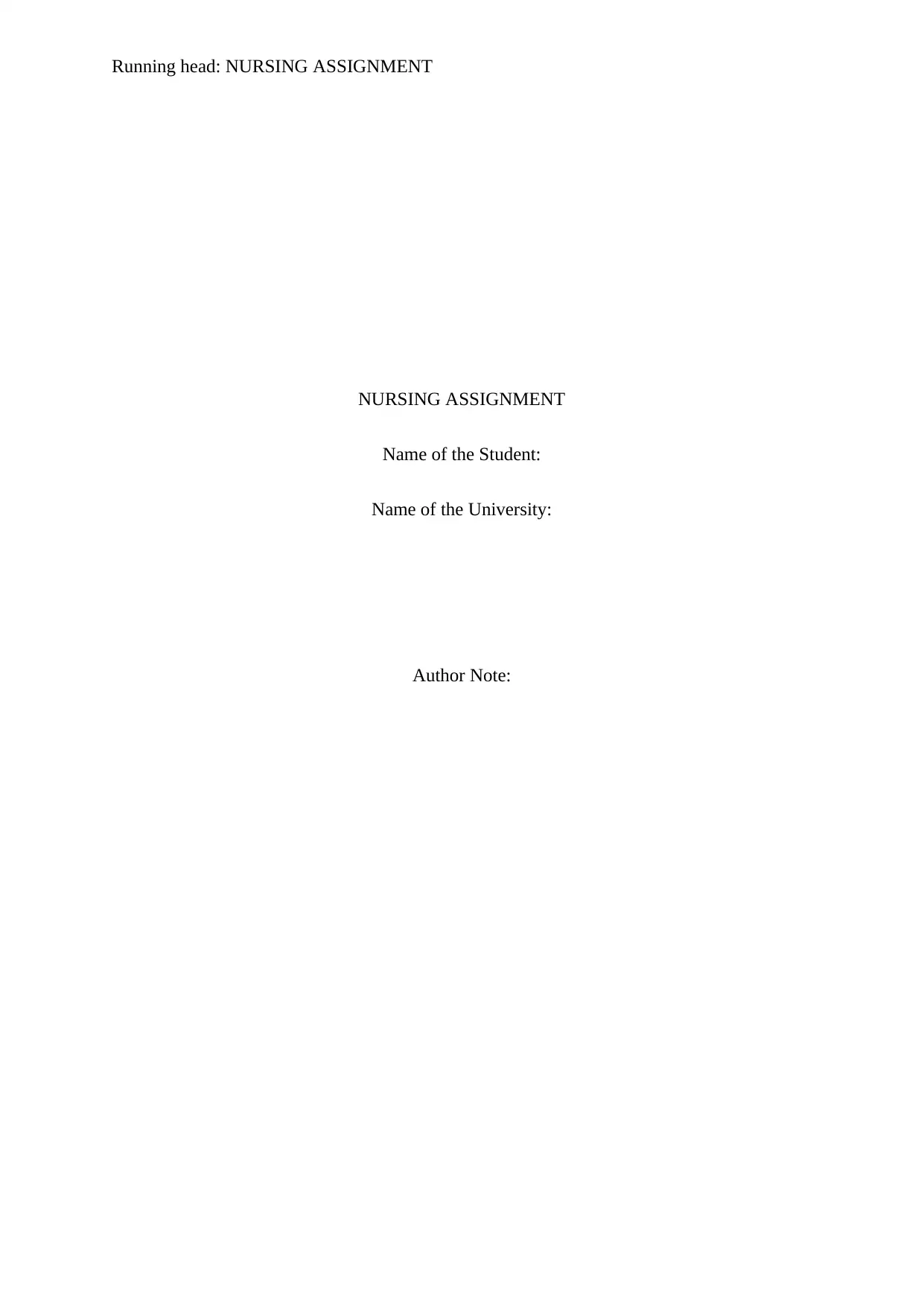
Running head: NURSING ASSIGNMENT
NURSING ASSIGNMENT
Name of the Student:
Name of the University:
Author Note:
NURSING ASSIGNMENT
Name of the Student:
Name of the University:
Author Note:
Paraphrase This Document
Need a fresh take? Get an instant paraphrase of this document with our AI Paraphraser
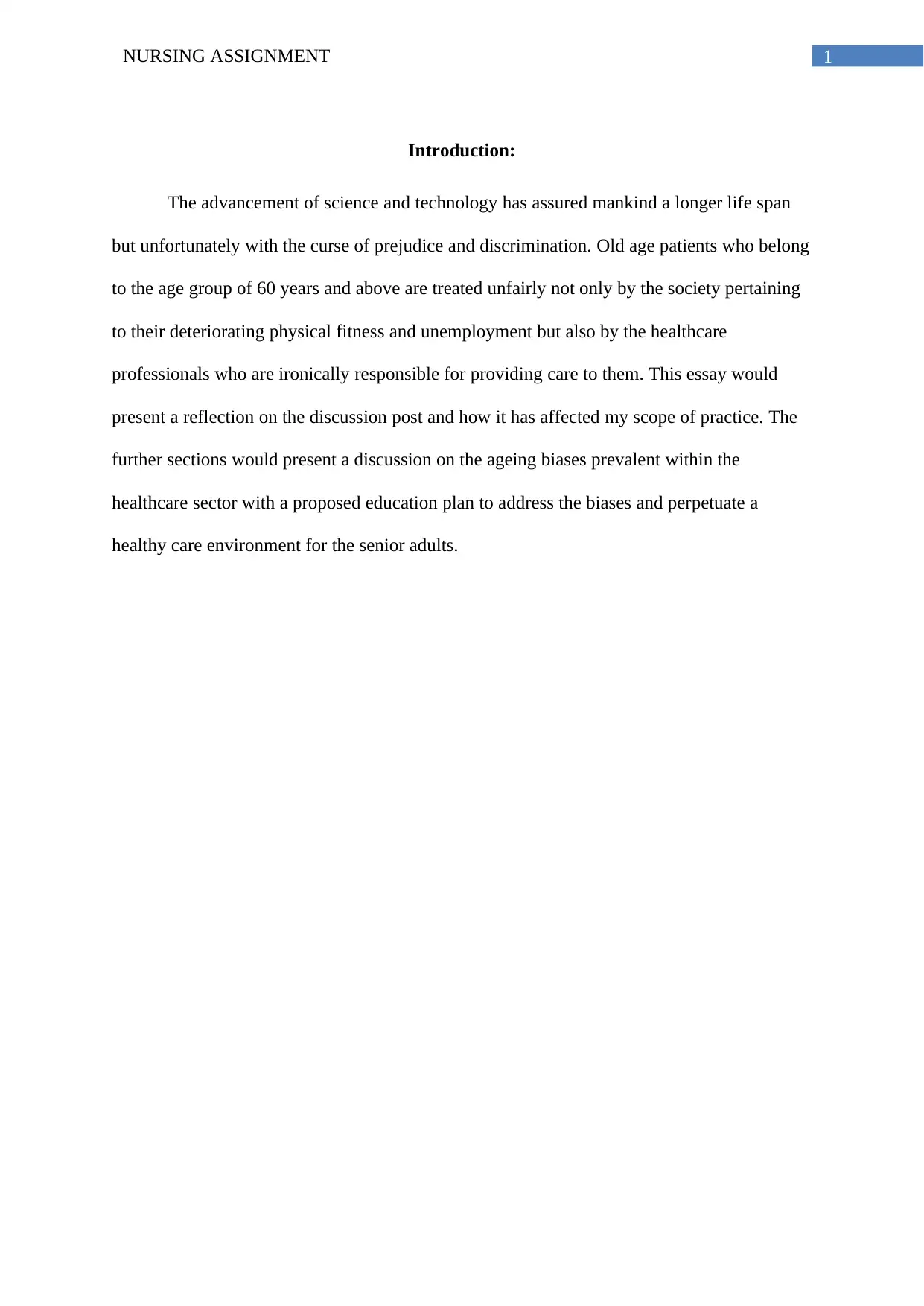
1NURSING ASSIGNMENT
Introduction:
The advancement of science and technology has assured mankind a longer life span
but unfortunately with the curse of prejudice and discrimination. Old age patients who belong
to the age group of 60 years and above are treated unfairly not only by the society pertaining
to their deteriorating physical fitness and unemployment but also by the healthcare
professionals who are ironically responsible for providing care to them. This essay would
present a reflection on the discussion post and how it has affected my scope of practice. The
further sections would present a discussion on the ageing biases prevalent within the
healthcare sector with a proposed education plan to address the biases and perpetuate a
healthy care environment for the senior adults.
Introduction:
The advancement of science and technology has assured mankind a longer life span
but unfortunately with the curse of prejudice and discrimination. Old age patients who belong
to the age group of 60 years and above are treated unfairly not only by the society pertaining
to their deteriorating physical fitness and unemployment but also by the healthcare
professionals who are ironically responsible for providing care to them. This essay would
present a reflection on the discussion post and how it has affected my scope of practice. The
further sections would present a discussion on the ageing biases prevalent within the
healthcare sector with a proposed education plan to address the biases and perpetuate a
healthy care environment for the senior adults.
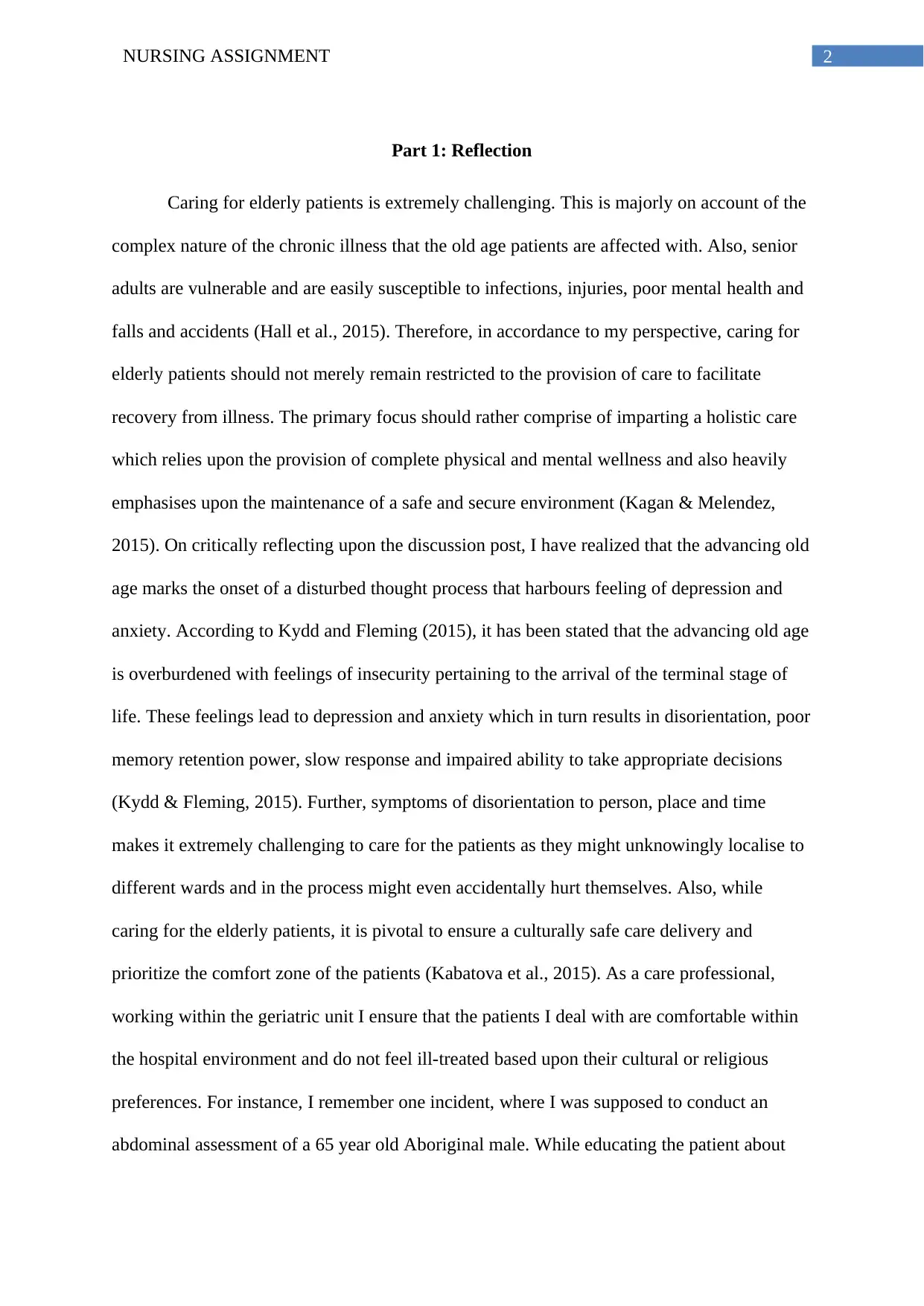
2NURSING ASSIGNMENT
Part 1: Reflection
Caring for elderly patients is extremely challenging. This is majorly on account of the
complex nature of the chronic illness that the old age patients are affected with. Also, senior
adults are vulnerable and are easily susceptible to infections, injuries, poor mental health and
falls and accidents (Hall et al., 2015). Therefore, in accordance to my perspective, caring for
elderly patients should not merely remain restricted to the provision of care to facilitate
recovery from illness. The primary focus should rather comprise of imparting a holistic care
which relies upon the provision of complete physical and mental wellness and also heavily
emphasises upon the maintenance of a safe and secure environment (Kagan & Melendez,
2015). On critically reflecting upon the discussion post, I have realized that the advancing old
age marks the onset of a disturbed thought process that harbours feeling of depression and
anxiety. According to Kydd and Fleming (2015), it has been stated that the advancing old age
is overburdened with feelings of insecurity pertaining to the arrival of the terminal stage of
life. These feelings lead to depression and anxiety which in turn results in disorientation, poor
memory retention power, slow response and impaired ability to take appropriate decisions
(Kydd & Fleming, 2015). Further, symptoms of disorientation to person, place and time
makes it extremely challenging to care for the patients as they might unknowingly localise to
different wards and in the process might even accidentally hurt themselves. Also, while
caring for the elderly patients, it is pivotal to ensure a culturally safe care delivery and
prioritize the comfort zone of the patients (Kabatova et al., 2015). As a care professional,
working within the geriatric unit I ensure that the patients I deal with are comfortable within
the hospital environment and do not feel ill-treated based upon their cultural or religious
preferences. For instance, I remember one incident, where I was supposed to conduct an
abdominal assessment of a 65 year old Aboriginal male. While educating the patient about
Part 1: Reflection
Caring for elderly patients is extremely challenging. This is majorly on account of the
complex nature of the chronic illness that the old age patients are affected with. Also, senior
adults are vulnerable and are easily susceptible to infections, injuries, poor mental health and
falls and accidents (Hall et al., 2015). Therefore, in accordance to my perspective, caring for
elderly patients should not merely remain restricted to the provision of care to facilitate
recovery from illness. The primary focus should rather comprise of imparting a holistic care
which relies upon the provision of complete physical and mental wellness and also heavily
emphasises upon the maintenance of a safe and secure environment (Kagan & Melendez,
2015). On critically reflecting upon the discussion post, I have realized that the advancing old
age marks the onset of a disturbed thought process that harbours feeling of depression and
anxiety. According to Kydd and Fleming (2015), it has been stated that the advancing old age
is overburdened with feelings of insecurity pertaining to the arrival of the terminal stage of
life. These feelings lead to depression and anxiety which in turn results in disorientation, poor
memory retention power, slow response and impaired ability to take appropriate decisions
(Kydd & Fleming, 2015). Further, symptoms of disorientation to person, place and time
makes it extremely challenging to care for the patients as they might unknowingly localise to
different wards and in the process might even accidentally hurt themselves. Also, while
caring for the elderly patients, it is pivotal to ensure a culturally safe care delivery and
prioritize the comfort zone of the patients (Kabatova et al., 2015). As a care professional,
working within the geriatric unit I ensure that the patients I deal with are comfortable within
the hospital environment and do not feel ill-treated based upon their cultural or religious
preferences. For instance, I remember one incident, where I was supposed to conduct an
abdominal assessment of a 65 year old Aboriginal male. While educating the patient about
⊘ This is a preview!⊘
Do you want full access?
Subscribe today to unlock all pages.

Trusted by 1+ million students worldwide
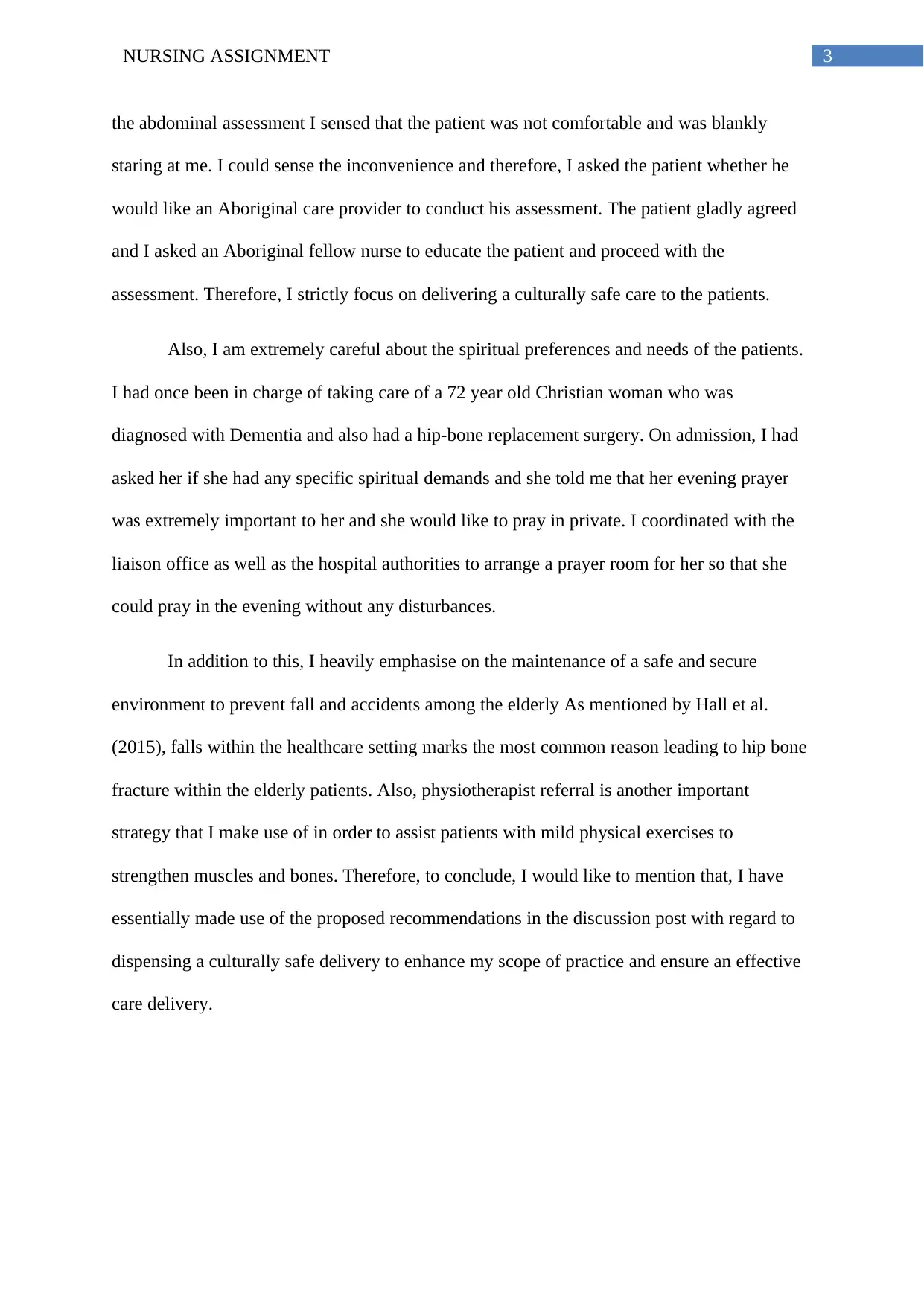
3NURSING ASSIGNMENT
the abdominal assessment I sensed that the patient was not comfortable and was blankly
staring at me. I could sense the inconvenience and therefore, I asked the patient whether he
would like an Aboriginal care provider to conduct his assessment. The patient gladly agreed
and I asked an Aboriginal fellow nurse to educate the patient and proceed with the
assessment. Therefore, I strictly focus on delivering a culturally safe care to the patients.
Also, I am extremely careful about the spiritual preferences and needs of the patients.
I had once been in charge of taking care of a 72 year old Christian woman who was
diagnosed with Dementia and also had a hip-bone replacement surgery. On admission, I had
asked her if she had any specific spiritual demands and she told me that her evening prayer
was extremely important to her and she would like to pray in private. I coordinated with the
liaison office as well as the hospital authorities to arrange a prayer room for her so that she
could pray in the evening without any disturbances.
In addition to this, I heavily emphasise on the maintenance of a safe and secure
environment to prevent fall and accidents among the elderly As mentioned by Hall et al.
(2015), falls within the healthcare setting marks the most common reason leading to hip bone
fracture within the elderly patients. Also, physiotherapist referral is another important
strategy that I make use of in order to assist patients with mild physical exercises to
strengthen muscles and bones. Therefore, to conclude, I would like to mention that, I have
essentially made use of the proposed recommendations in the discussion post with regard to
dispensing a culturally safe delivery to enhance my scope of practice and ensure an effective
care delivery.
the abdominal assessment I sensed that the patient was not comfortable and was blankly
staring at me. I could sense the inconvenience and therefore, I asked the patient whether he
would like an Aboriginal care provider to conduct his assessment. The patient gladly agreed
and I asked an Aboriginal fellow nurse to educate the patient and proceed with the
assessment. Therefore, I strictly focus on delivering a culturally safe care to the patients.
Also, I am extremely careful about the spiritual preferences and needs of the patients.
I had once been in charge of taking care of a 72 year old Christian woman who was
diagnosed with Dementia and also had a hip-bone replacement surgery. On admission, I had
asked her if she had any specific spiritual demands and she told me that her evening prayer
was extremely important to her and she would like to pray in private. I coordinated with the
liaison office as well as the hospital authorities to arrange a prayer room for her so that she
could pray in the evening without any disturbances.
In addition to this, I heavily emphasise on the maintenance of a safe and secure
environment to prevent fall and accidents among the elderly As mentioned by Hall et al.
(2015), falls within the healthcare setting marks the most common reason leading to hip bone
fracture within the elderly patients. Also, physiotherapist referral is another important
strategy that I make use of in order to assist patients with mild physical exercises to
strengthen muscles and bones. Therefore, to conclude, I would like to mention that, I have
essentially made use of the proposed recommendations in the discussion post with regard to
dispensing a culturally safe delivery to enhance my scope of practice and ensure an effective
care delivery.
Paraphrase This Document
Need a fresh take? Get an instant paraphrase of this document with our AI Paraphraser
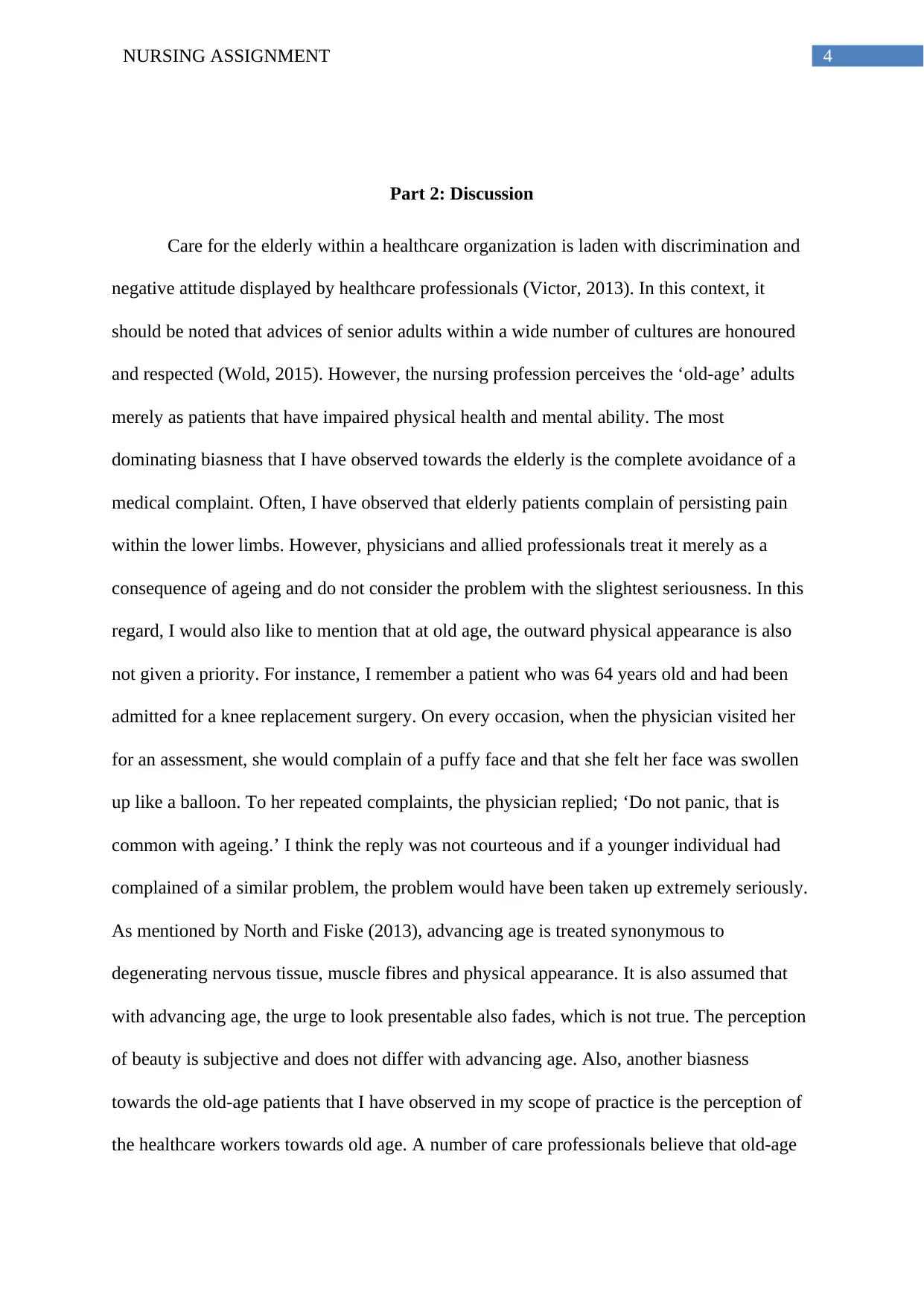
4NURSING ASSIGNMENT
Part 2: Discussion
Care for the elderly within a healthcare organization is laden with discrimination and
negative attitude displayed by healthcare professionals (Victor, 2013). In this context, it
should be noted that advices of senior adults within a wide number of cultures are honoured
and respected (Wold, 2015). However, the nursing profession perceives the ‘old-age’ adults
merely as patients that have impaired physical health and mental ability. The most
dominating biasness that I have observed towards the elderly is the complete avoidance of a
medical complaint. Often, I have observed that elderly patients complain of persisting pain
within the lower limbs. However, physicians and allied professionals treat it merely as a
consequence of ageing and do not consider the problem with the slightest seriousness. In this
regard, I would also like to mention that at old age, the outward physical appearance is also
not given a priority. For instance, I remember a patient who was 64 years old and had been
admitted for a knee replacement surgery. On every occasion, when the physician visited her
for an assessment, she would complain of a puffy face and that she felt her face was swollen
up like a balloon. To her repeated complaints, the physician replied; ‘Do not panic, that is
common with ageing.’ I think the reply was not courteous and if a younger individual had
complained of a similar problem, the problem would have been taken up extremely seriously.
As mentioned by North and Fiske (2013), advancing age is treated synonymous to
degenerating nervous tissue, muscle fibres and physical appearance. It is also assumed that
with advancing age, the urge to look presentable also fades, which is not true. The perception
of beauty is subjective and does not differ with advancing age. Also, another biasness
towards the old-age patients that I have observed in my scope of practice is the perception of
the healthcare workers towards old age. A number of care professionals believe that old-age
Part 2: Discussion
Care for the elderly within a healthcare organization is laden with discrimination and
negative attitude displayed by healthcare professionals (Victor, 2013). In this context, it
should be noted that advices of senior adults within a wide number of cultures are honoured
and respected (Wold, 2015). However, the nursing profession perceives the ‘old-age’ adults
merely as patients that have impaired physical health and mental ability. The most
dominating biasness that I have observed towards the elderly is the complete avoidance of a
medical complaint. Often, I have observed that elderly patients complain of persisting pain
within the lower limbs. However, physicians and allied professionals treat it merely as a
consequence of ageing and do not consider the problem with the slightest seriousness. In this
regard, I would also like to mention that at old age, the outward physical appearance is also
not given a priority. For instance, I remember a patient who was 64 years old and had been
admitted for a knee replacement surgery. On every occasion, when the physician visited her
for an assessment, she would complain of a puffy face and that she felt her face was swollen
up like a balloon. To her repeated complaints, the physician replied; ‘Do not panic, that is
common with ageing.’ I think the reply was not courteous and if a younger individual had
complained of a similar problem, the problem would have been taken up extremely seriously.
As mentioned by North and Fiske (2013), advancing age is treated synonymous to
degenerating nervous tissue, muscle fibres and physical appearance. It is also assumed that
with advancing age, the urge to look presentable also fades, which is not true. The perception
of beauty is subjective and does not differ with advancing age. Also, another biasness
towards the old-age patients that I have observed in my scope of practice is the perception of
the healthcare workers towards old age. A number of care professionals believe that old-age
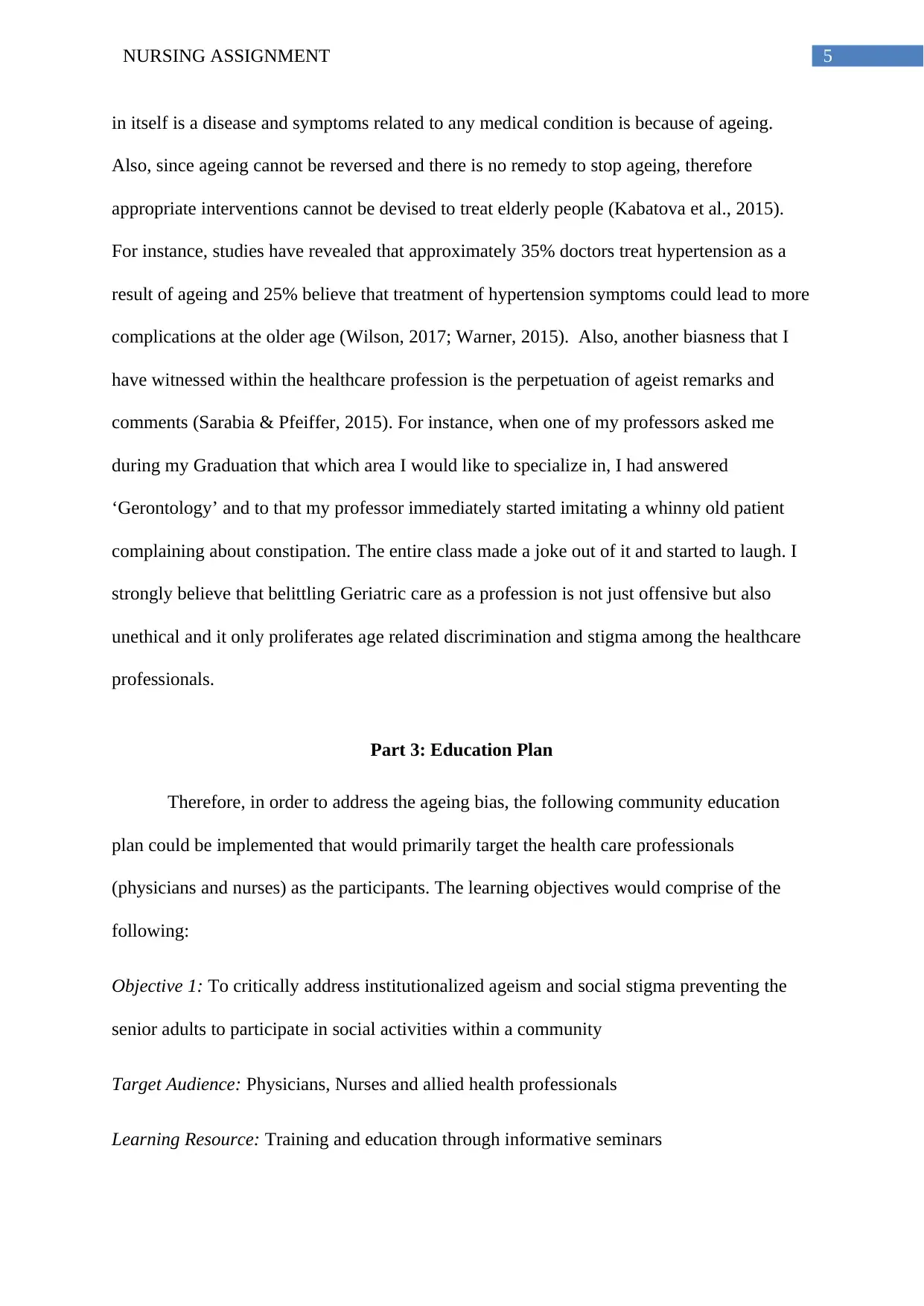
5NURSING ASSIGNMENT
in itself is a disease and symptoms related to any medical condition is because of ageing.
Also, since ageing cannot be reversed and there is no remedy to stop ageing, therefore
appropriate interventions cannot be devised to treat elderly people (Kabatova et al., 2015).
For instance, studies have revealed that approximately 35% doctors treat hypertension as a
result of ageing and 25% believe that treatment of hypertension symptoms could lead to more
complications at the older age (Wilson, 2017; Warner, 2015). Also, another biasness that I
have witnessed within the healthcare profession is the perpetuation of ageist remarks and
comments (Sarabia & Pfeiffer, 2015). For instance, when one of my professors asked me
during my Graduation that which area I would like to specialize in, I had answered
‘Gerontology’ and to that my professor immediately started imitating a whinny old patient
complaining about constipation. The entire class made a joke out of it and started to laugh. I
strongly believe that belittling Geriatric care as a profession is not just offensive but also
unethical and it only proliferates age related discrimination and stigma among the healthcare
professionals.
Part 3: Education Plan
Therefore, in order to address the ageing bias, the following community education
plan could be implemented that would primarily target the health care professionals
(physicians and nurses) as the participants. The learning objectives would comprise of the
following:
Objective 1: To critically address institutionalized ageism and social stigma preventing the
senior adults to participate in social activities within a community
Target Audience: Physicians, Nurses and allied health professionals
Learning Resource: Training and education through informative seminars
in itself is a disease and symptoms related to any medical condition is because of ageing.
Also, since ageing cannot be reversed and there is no remedy to stop ageing, therefore
appropriate interventions cannot be devised to treat elderly people (Kabatova et al., 2015).
For instance, studies have revealed that approximately 35% doctors treat hypertension as a
result of ageing and 25% believe that treatment of hypertension symptoms could lead to more
complications at the older age (Wilson, 2017; Warner, 2015). Also, another biasness that I
have witnessed within the healthcare profession is the perpetuation of ageist remarks and
comments (Sarabia & Pfeiffer, 2015). For instance, when one of my professors asked me
during my Graduation that which area I would like to specialize in, I had answered
‘Gerontology’ and to that my professor immediately started imitating a whinny old patient
complaining about constipation. The entire class made a joke out of it and started to laugh. I
strongly believe that belittling Geriatric care as a profession is not just offensive but also
unethical and it only proliferates age related discrimination and stigma among the healthcare
professionals.
Part 3: Education Plan
Therefore, in order to address the ageing bias, the following community education
plan could be implemented that would primarily target the health care professionals
(physicians and nurses) as the participants. The learning objectives would comprise of the
following:
Objective 1: To critically address institutionalized ageism and social stigma preventing the
senior adults to participate in social activities within a community
Target Audience: Physicians, Nurses and allied health professionals
Learning Resource: Training and education through informative seminars
⊘ This is a preview!⊘
Do you want full access?
Subscribe today to unlock all pages.

Trusted by 1+ million students worldwide
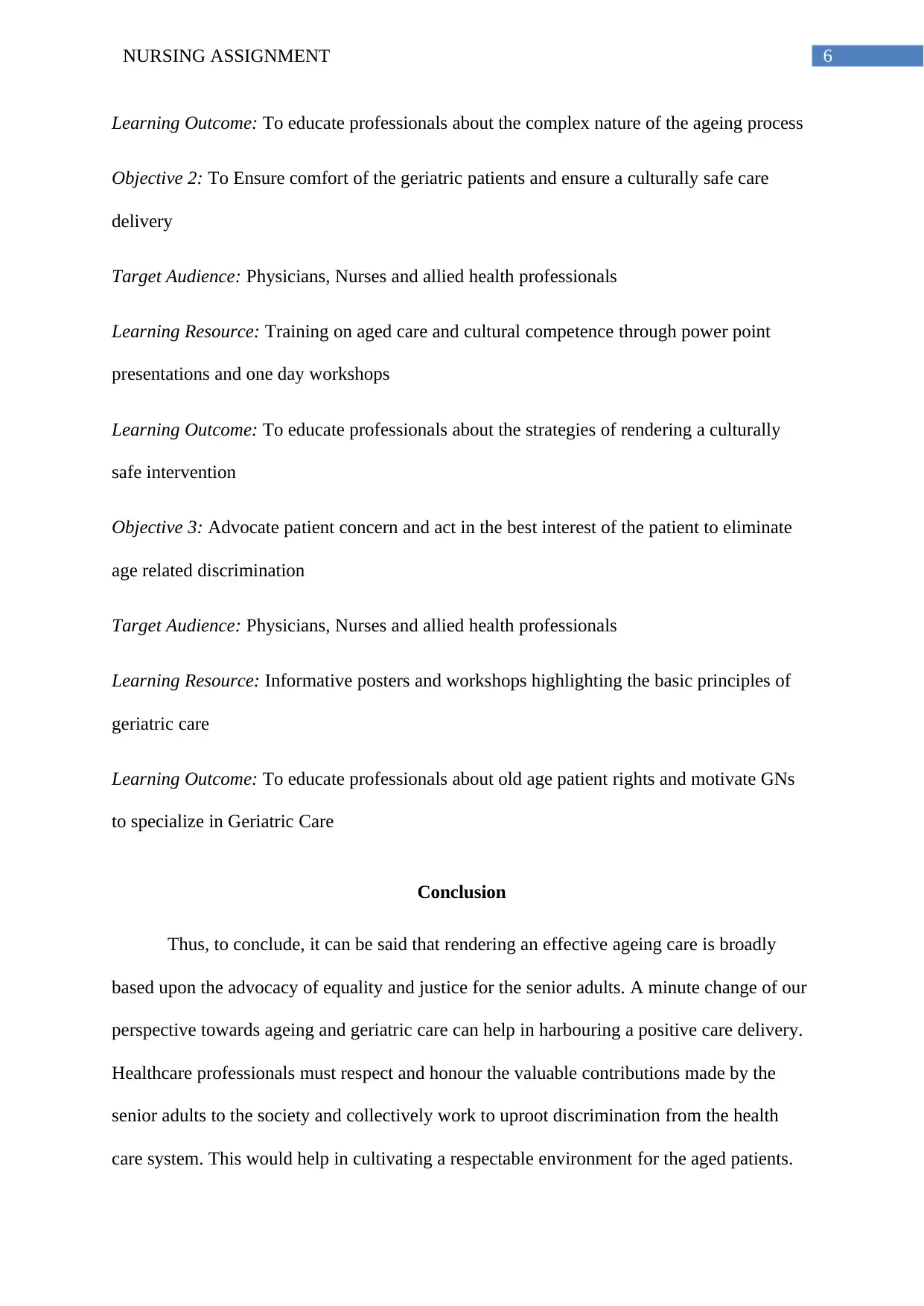
6NURSING ASSIGNMENT
Learning Outcome: To educate professionals about the complex nature of the ageing process
Objective 2: To Ensure comfort of the geriatric patients and ensure a culturally safe care
delivery
Target Audience: Physicians, Nurses and allied health professionals
Learning Resource: Training on aged care and cultural competence through power point
presentations and one day workshops
Learning Outcome: To educate professionals about the strategies of rendering a culturally
safe intervention
Objective 3: Advocate patient concern and act in the best interest of the patient to eliminate
age related discrimination
Target Audience: Physicians, Nurses and allied health professionals
Learning Resource: Informative posters and workshops highlighting the basic principles of
geriatric care
Learning Outcome: To educate professionals about old age patient rights and motivate GNs
to specialize in Geriatric Care
Conclusion
Thus, to conclude, it can be said that rendering an effective ageing care is broadly
based upon the advocacy of equality and justice for the senior adults. A minute change of our
perspective towards ageing and geriatric care can help in harbouring a positive care delivery.
Healthcare professionals must respect and honour the valuable contributions made by the
senior adults to the society and collectively work to uproot discrimination from the health
care system. This would help in cultivating a respectable environment for the aged patients.
Learning Outcome: To educate professionals about the complex nature of the ageing process
Objective 2: To Ensure comfort of the geriatric patients and ensure a culturally safe care
delivery
Target Audience: Physicians, Nurses and allied health professionals
Learning Resource: Training on aged care and cultural competence through power point
presentations and one day workshops
Learning Outcome: To educate professionals about the strategies of rendering a culturally
safe intervention
Objective 3: Advocate patient concern and act in the best interest of the patient to eliminate
age related discrimination
Target Audience: Physicians, Nurses and allied health professionals
Learning Resource: Informative posters and workshops highlighting the basic principles of
geriatric care
Learning Outcome: To educate professionals about old age patient rights and motivate GNs
to specialize in Geriatric Care
Conclusion
Thus, to conclude, it can be said that rendering an effective ageing care is broadly
based upon the advocacy of equality and justice for the senior adults. A minute change of our
perspective towards ageing and geriatric care can help in harbouring a positive care delivery.
Healthcare professionals must respect and honour the valuable contributions made by the
senior adults to the society and collectively work to uproot discrimination from the health
care system. This would help in cultivating a respectable environment for the aged patients.
Paraphrase This Document
Need a fresh take? Get an instant paraphrase of this document with our AI Paraphraser
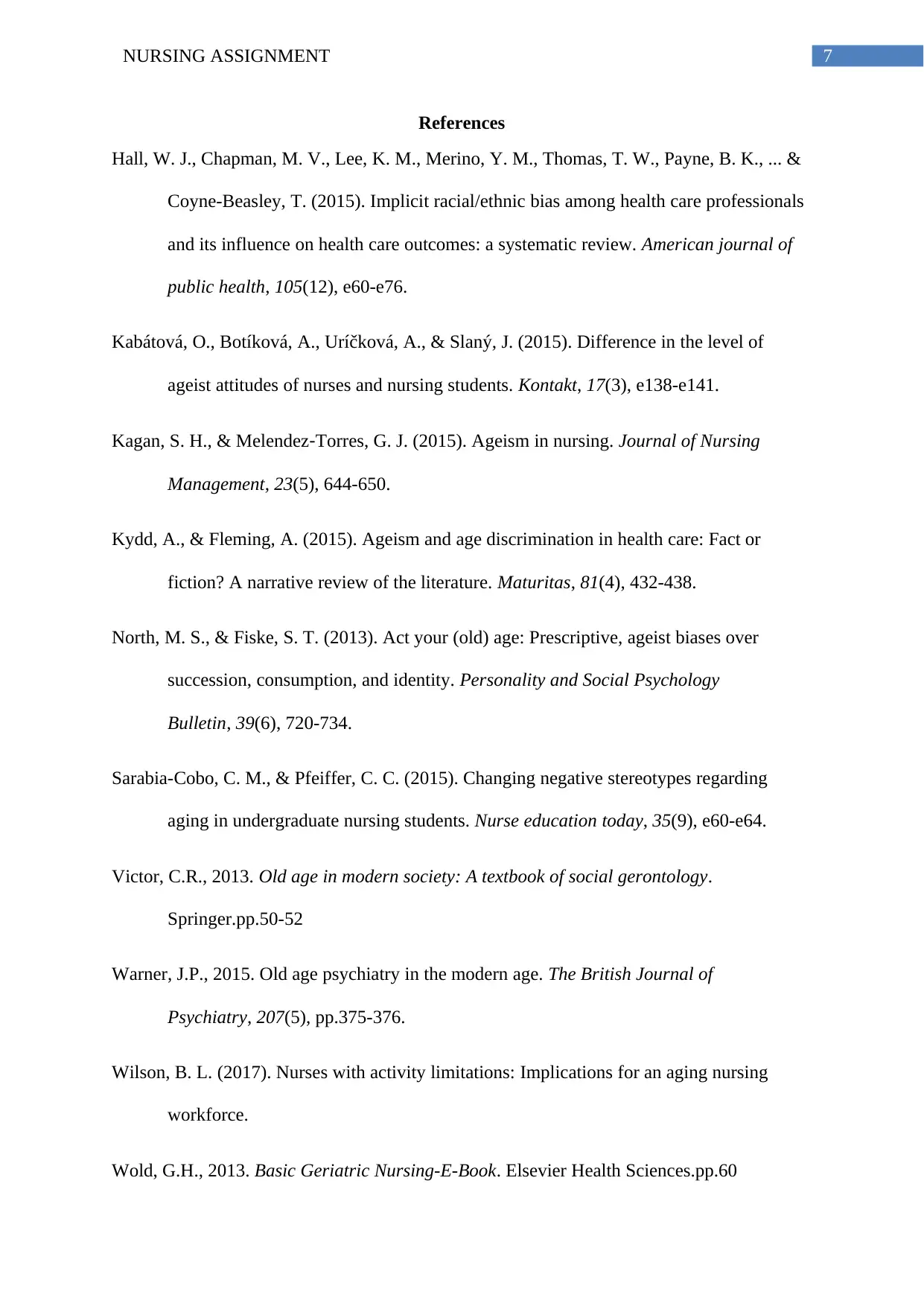
7NURSING ASSIGNMENT
References
Hall, W. J., Chapman, M. V., Lee, K. M., Merino, Y. M., Thomas, T. W., Payne, B. K., ... &
Coyne-Beasley, T. (2015). Implicit racial/ethnic bias among health care professionals
and its influence on health care outcomes: a systematic review. American journal of
public health, 105(12), e60-e76.
Kabátová, O., Botíková, A., Uríčková, A., & Slaný, J. (2015). Difference in the level of
ageist attitudes of nurses and nursing students. Kontakt, 17(3), e138-e141.
Kagan, S. H., & Melendez‐Torres, G. J. (2015). Ageism in nursing. Journal of Nursing
Management, 23(5), 644-650.
Kydd, A., & Fleming, A. (2015). Ageism and age discrimination in health care: Fact or
fiction? A narrative review of the literature. Maturitas, 81(4), 432-438.
North, M. S., & Fiske, S. T. (2013). Act your (old) age: Prescriptive, ageist biases over
succession, consumption, and identity. Personality and Social Psychology
Bulletin, 39(6), 720-734.
Sarabia-Cobo, C. M., & Pfeiffer, C. C. (2015). Changing negative stereotypes regarding
aging in undergraduate nursing students. Nurse education today, 35(9), e60-e64.
Victor, C.R., 2013. Old age in modern society: A textbook of social gerontology.
Springer.pp.50-52
Warner, J.P., 2015. Old age psychiatry in the modern age. The British Journal of
Psychiatry, 207(5), pp.375-376.
Wilson, B. L. (2017). Nurses with activity limitations: Implications for an aging nursing
workforce.
Wold, G.H., 2013. Basic Geriatric Nursing-E-Book. Elsevier Health Sciences.pp.60
References
Hall, W. J., Chapman, M. V., Lee, K. M., Merino, Y. M., Thomas, T. W., Payne, B. K., ... &
Coyne-Beasley, T. (2015). Implicit racial/ethnic bias among health care professionals
and its influence on health care outcomes: a systematic review. American journal of
public health, 105(12), e60-e76.
Kabátová, O., Botíková, A., Uríčková, A., & Slaný, J. (2015). Difference in the level of
ageist attitudes of nurses and nursing students. Kontakt, 17(3), e138-e141.
Kagan, S. H., & Melendez‐Torres, G. J. (2015). Ageism in nursing. Journal of Nursing
Management, 23(5), 644-650.
Kydd, A., & Fleming, A. (2015). Ageism and age discrimination in health care: Fact or
fiction? A narrative review of the literature. Maturitas, 81(4), 432-438.
North, M. S., & Fiske, S. T. (2013). Act your (old) age: Prescriptive, ageist biases over
succession, consumption, and identity. Personality and Social Psychology
Bulletin, 39(6), 720-734.
Sarabia-Cobo, C. M., & Pfeiffer, C. C. (2015). Changing negative stereotypes regarding
aging in undergraduate nursing students. Nurse education today, 35(9), e60-e64.
Victor, C.R., 2013. Old age in modern society: A textbook of social gerontology.
Springer.pp.50-52
Warner, J.P., 2015. Old age psychiatry in the modern age. The British Journal of
Psychiatry, 207(5), pp.375-376.
Wilson, B. L. (2017). Nurses with activity limitations: Implications for an aging nursing
workforce.
Wold, G.H., 2013. Basic Geriatric Nursing-E-Book. Elsevier Health Sciences.pp.60
1 out of 8
Related Documents
Your All-in-One AI-Powered Toolkit for Academic Success.
+13062052269
info@desklib.com
Available 24*7 on WhatsApp / Email
![[object Object]](/_next/static/media/star-bottom.7253800d.svg)
Unlock your academic potential
Copyright © 2020–2025 A2Z Services. All Rights Reserved. Developed and managed by ZUCOL.





